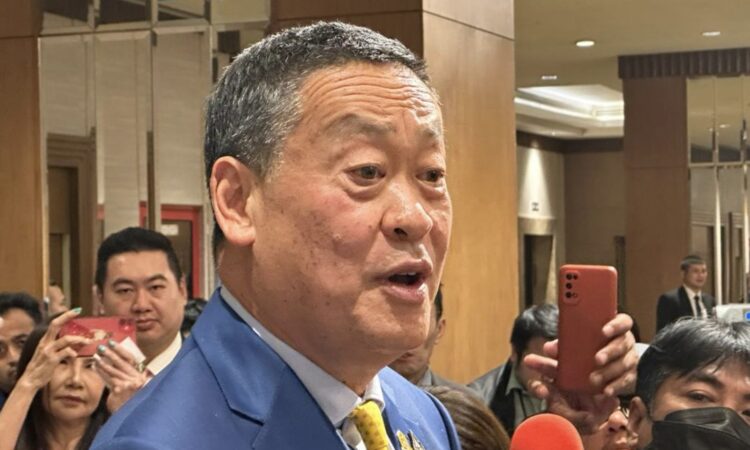
BANGKOK – Thailand hopes China will help build a US$2.8 billion, east-west highway and railway “Land Bridge” across the kingdom, linking the Andaman Sea and Gulf of Thailand as a short-cut for oil and other international cargo currently sailing further south via Singapore and the Malacca Strait.
Inland southern China could then also use existing north-south roads and rails to enable Chinese overland access, for the first time, to southern Thailand’s two planned deep-sea ports on the Andaman and Gulf coasts, opening westward to the Indian Ocean and east to the Pacific.
Thailand describes the Land Bridge plan as a faster, shorter and cheaper route for international shipping compared to the narrow, congested, southern Strait of Malacca wedged between Singapore and Indonesia.
The scheme marks a scaled-down version of the often-proposed but never-realized Kra Canal, more recently dubbed the Thai Canal, which envisions digging a channel across southern Thailand’s narrow Kra isthmus.

The canal scheme, which would could cost upwards of $25 billion by some estimates, has sunk on a constitutional provision that defines the kingdom as “indivisible.” The Land Bridge concept, the project’s advocates say, dodges any potential legal challenge.
The Land Bridge could also become an alternative route if hostilities erupt in the region and the Malacca Strait is blockaded by the US as a way to disrupt China’s trade and energy imports from the Middle East – a strategic chokepoint often referred to as China’s “Malacca dilemma.”
Many of the international ships passing Singapore carry Middle Eastern oil and other products to China, Japan, South Korea, Taiwan, the Philippines and elsewhere in the Pacific.
The Beijing-headquartered Asian Infrastructure Investment Bank (AIIB) “really like our policy, particularly the Land Bridge project, which I am confident they will take part in,” Thai Prime Minister Srettha Thavisin said after meeting the AIIB president in February.
“I will have official talk to them,” Srettha said, the Bangkok Post reported on February 4.
Bangkok plans to send “a Land Bridge megaproject roadshow” headed by Thailand’s transportation ministry to China in March in a bid to attract Chinese government and private investment to the 100-kilometer-long megaproject, which includes gas and oil pipelines, warehouses and other infrastructure.
Thailand’s transport ministry was expected to give a detailed report about the Land Bridge to the Chinese Embassy in Bangkok later in February to prepare for the roadshow, local media reported. If built, the Land Bridge would be open to worldwide shipping, officials said.
“Today, the world collaborates, not just competes,” said Deputy Prime Minister and Interior Minister Anutin Charnvirakul.
Chinese Foreign Minister Wang Yi recently visited Thailand and expressed interest in the project, Srettha claimed.
The premier also somewhat awkwardly pitched the project to Washington’s ambassador in Bangkok, Robert Godec, during an American Chamber of Commerce meeting last October, at which the premier made the keynote address to a banquet room full of hundreds of American executives and investors.
It’s still unclear how the US, including the Pentagon, views the proposed project from a military perspective, including its potential to provide China with an alternative shipping route in a potential conflict scenario where the US Navy bids to block Chinese ships in the Malacca Strait chokepoint to put economic pressure on Beijing.

Security analysts suggest the US could resort to a Malacca blockade, launching warships from Singapore, if a war over Taiwan erupted. It’s also possible, the same analysts suggest, that the US could seek to block Thailand’s Land Bridge on the Andaman side, putting Thailand in a potentially delicate diplomatic spot in the event of a Taiwan war.
Last month, at the World Economic Forum in Davos, Switzerland, the Thai prime minister outlined the plan to US, Japanese, and other potential investors, including Sultan Ahmed bin Sulayem, CEO of Dubai Port (DP) World, a logistics company based in the United Arab Emirates.
As a result, Transportation Minister Suriya Jungrungreangkit will go to Dubai soon to meet DP officials, Srettha said.
“The key factor that makes the investors interested in the project is the 10% internal rate of return they will receive from the project,” Suriya said.
Among foreign shippers, China could increase its international market prowess by using the Land Bridge because most of its exports to Europe currently sail the longer route through the Malacca Strait.
The Land Bridge would connect Ranong port, on southwest Thailand’s Andaman Sea, with Chumphon port on the southeast coast along the Gulf of Thailand.
Railway stations and coast-to-coast train facilities would be built while construction crews lay a sleek highway across rocky hills and jungles to service the two seaports.
On each coast, cargo ships would end their journey, dock and unload their goods onto waiting trains and trucks.
The cargo would cross Thailand to the opposite coast, where the goods would be loaded onto ships that start their journey in that port.
However, the logistics, time and cost of unloading and reloading ships to move cargo by road have already sparked critical commentary of the scheme, with some claiming it will be uneconomic for shippers compared to the Malacca Strait route.
The Land Bridge’s proposed east coast port, Chumphon, is somewhat close to Thailand’s international investor-friendly Eastern Economic Corridor (EEC), designed to attract high-tech industries.
U-Tapao International Airport and Thailand’s busiest deep-sea port at Laem Chabang, in Chon Buri province, are also near Chumphon’s seaport on the Gulf of Thailand.
Dubai Ports is reportedly a shareholder in a joint container terminal venture at Laem Chabang International Terminal.
“The government conducted this megaproject with the current geopolitical scene in mind, as the country has no conflicts with other nations,” Srettha told Parliament on January 4.
Richard S. Ehrlich is a Bangkok-based American foreign correspondent reporting from Asia since 1978. Excerpts from his two new nonfiction books, “Rituals. Killers. Wars. & Sex. — Tibet, India, Nepal, Laos, Vietnam, Afghanistan, Sri Lanka & New York” and “Apocalyptic Tribes, Smugglers & Freaks” are available here.
Shawn W Crispin contributed reporting from Bangkok.
